Supplementary data: Quebec
This page provides data visualizations related to the priorities for Canada’s cancer system, as well as accessible descriptions.
Download data tables for all indicators.
Priority 1 Action 1: Help people to stop smoking or not start in the first place and live healthier lives
Topic: Keeping people smoke-free
Title of image: Percentage of people in Quebec (aged ≥ 12) classified as daily or occasional smokers in 2020
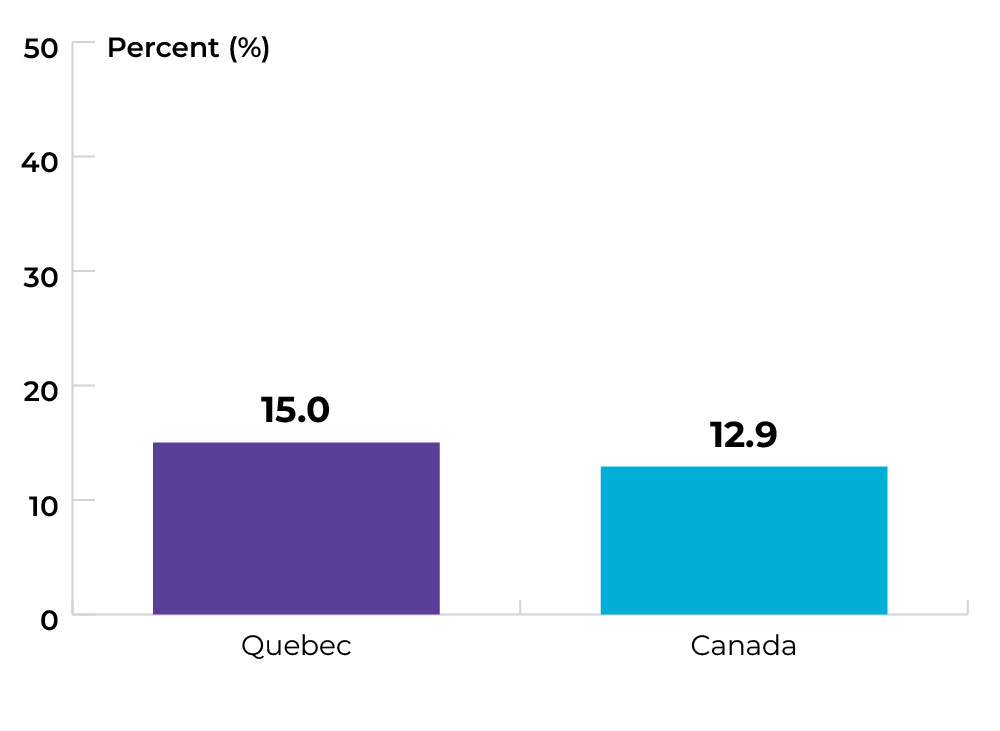
Data source : Canadian Community Health Survey
Topic: Maintaining healthy body weight
Title of image: Percentage of people in Quebec (aged ≥ 18) classified as being overweight or obese in 2019
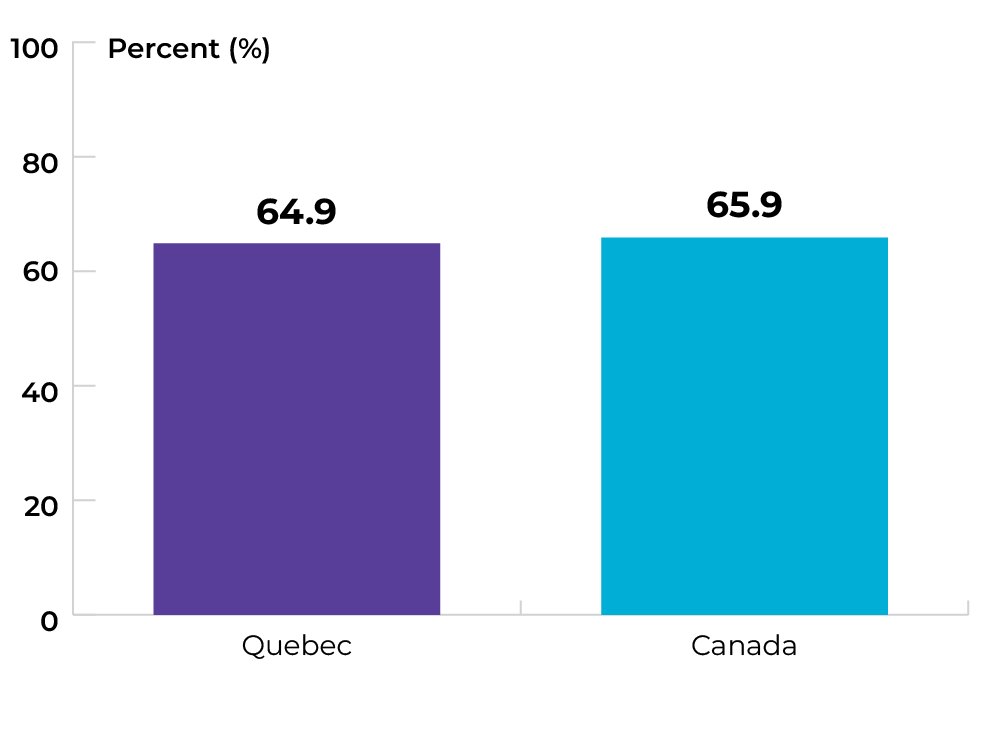
Data source: Canadian Community Health Survey
Topic: Maintaining healthy body weight
Title of image: Percentage of people in Quebec (aged ≥ 18) classified as being overweight or obese in 2017-2018, by income quintile and by sex
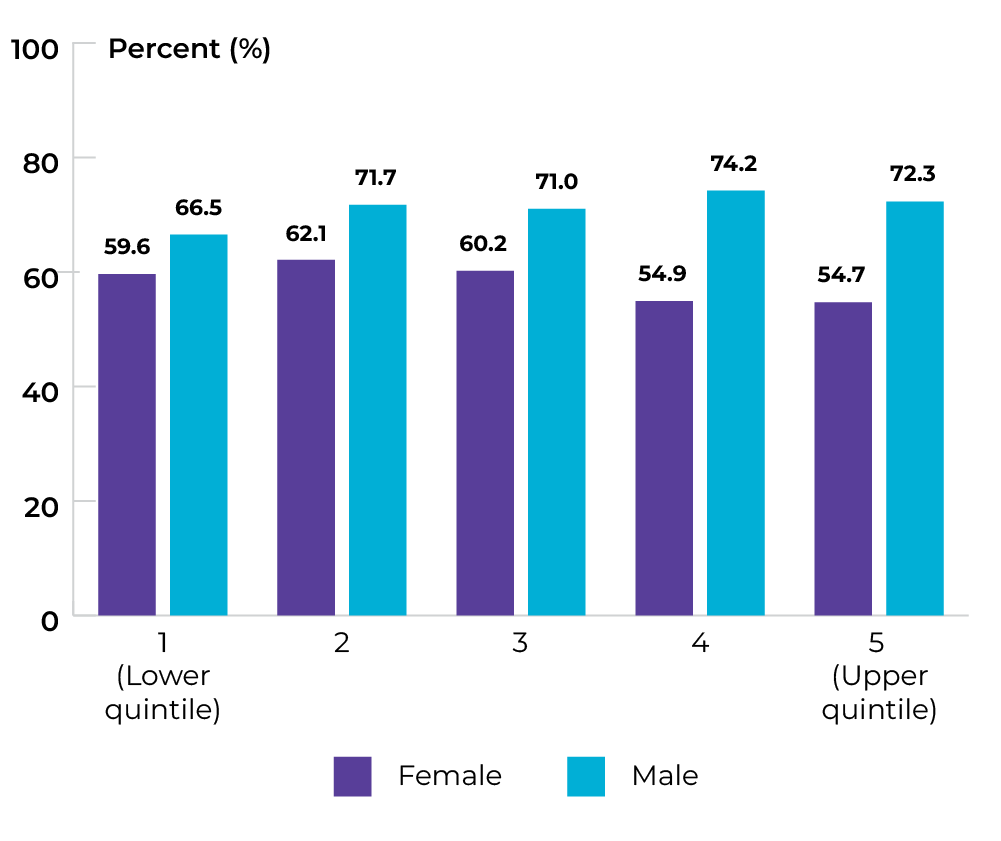
Title of table: Percentage of people in Quebec (aged ≥ 18) classified as being overweight or obese in 2017-2018, by income quintile and by sex
| Sex | Quintile 1 | Quintile 2 | Quintile 3 | Quintile 4 | Quintile 5 |
|---|---|---|---|---|---|
| Female | 59.6% | 62.1% | 60.2% | 54.9% | 54.7% |
| Male | 66.5% | 71.7% | 71.0% | 74.2% | 72.3% |
Data source : Canadian Community Health Survey
Topic: Maintaining healthy body weight
Title of image: Percentage of people in Quebec (aged ≥ 18) classified as being overweight or obese in 2019, by sex
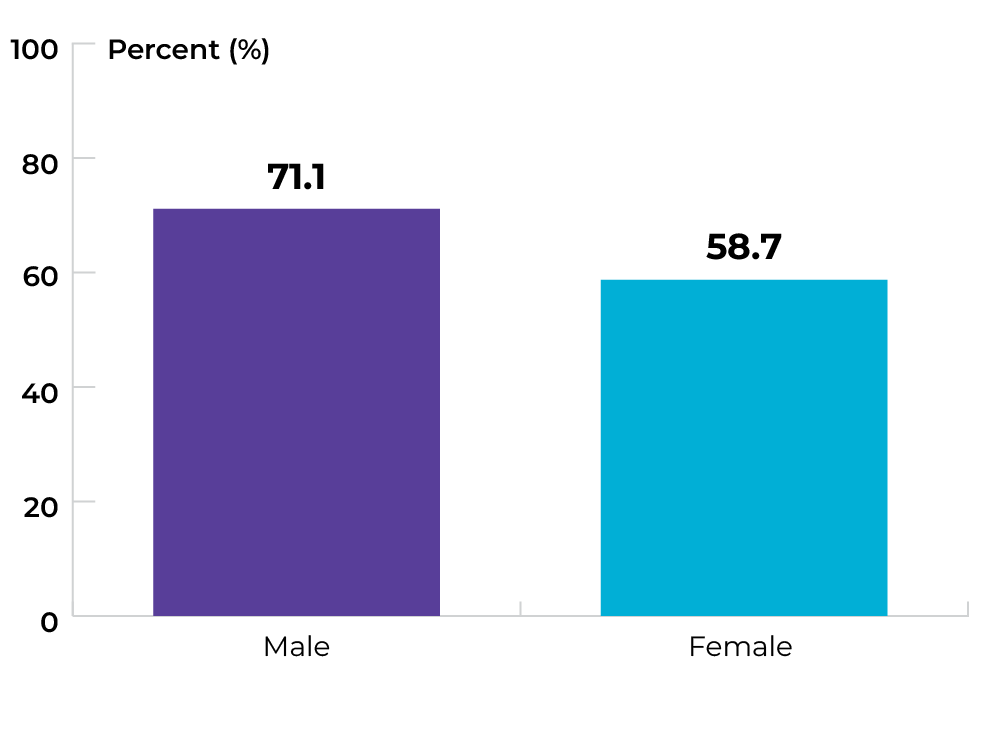
Data source: Canadian Community Health Survey
Priority 1 Action 2: Adopt proven practices known to reduce the risk of cancer
Topic: Increasing HPV vaccination
Title of image: Percentage of Grade 4 elementary school students vaccinated for HPV from 2018 to 2019
Immunization coverage varies from 71 to 90% in girls and from 62 to 88% in boys, based on the school attendance area.
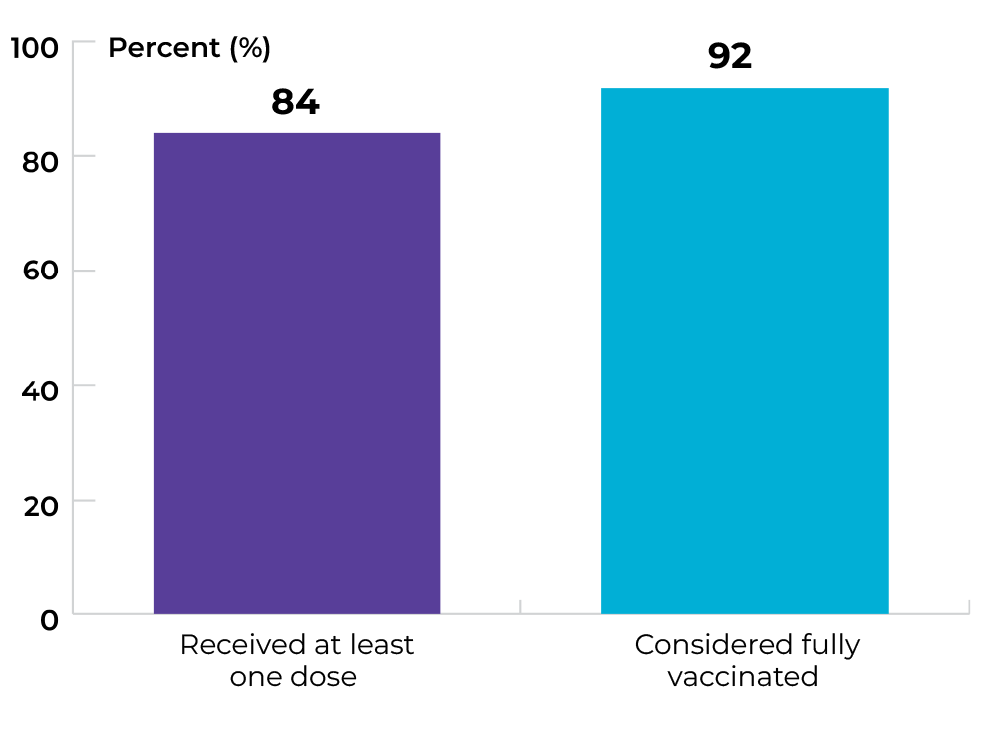
Data source: Flash Vigie – Septembre 2019 – Vol. 14, no 7
Topic: Increasing HPV vaccination
Title of image: Percentage of initial and catch-up HPV vaccinations for Grade 4 elementary school students in 2018 and 2019
Immunization coverage varies from 71 to 90% in girls and from 62 to 88% in boys, based on the school attendance area.
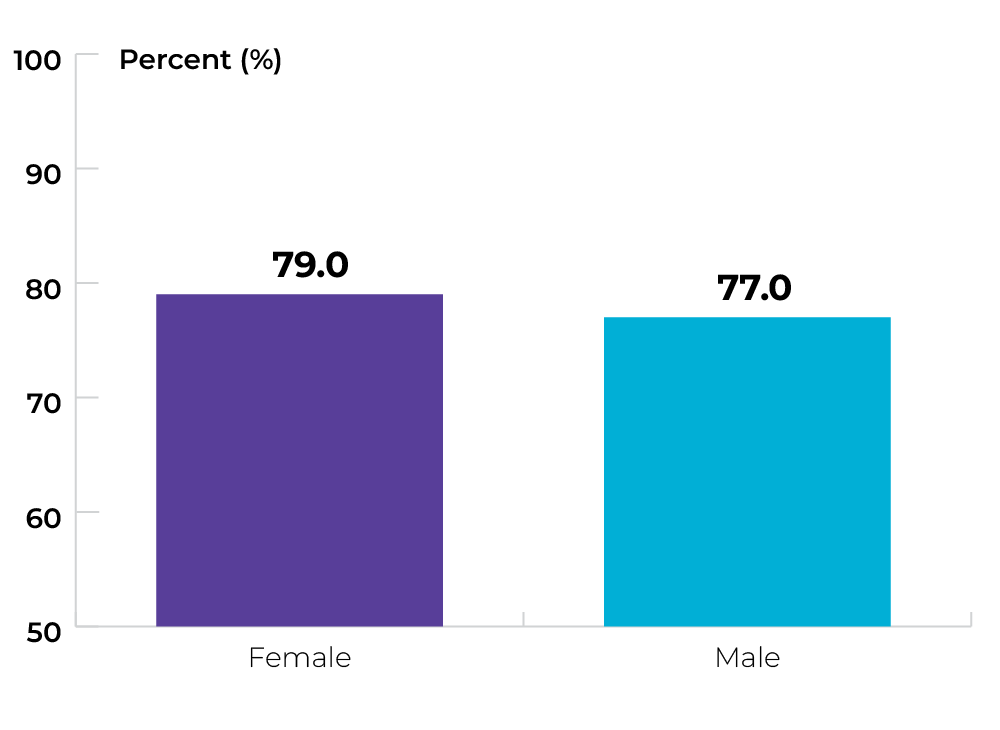
Data source: Flash Vigie – Septembre 2019 – Vol. 14, no 7
Priority 2 Action 2: Strengthen existing screening efforts and implement lung cancer screening programs across the country
Topic: Increasing participation in colorectal cancer screening
Title of image: Immunochemical fecal occult blood test (iFOBT) screening coverage rate among individuals aged 50 to 74
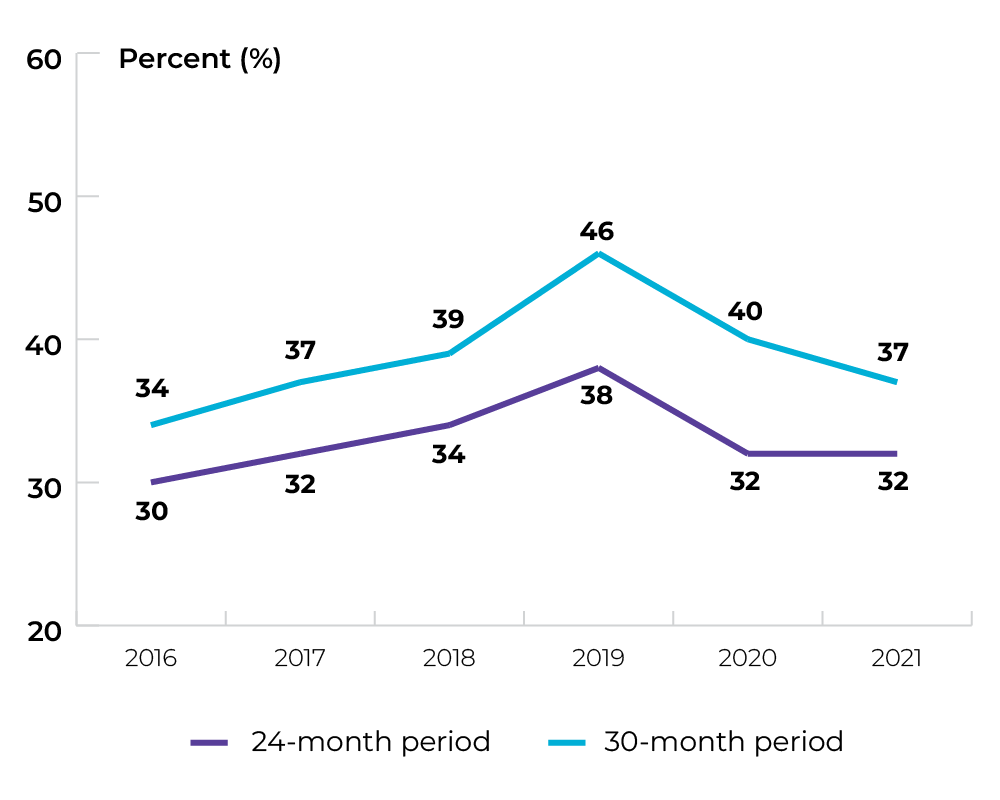
Title of table: Immunochemical fecal occult blood test (iFOBT) screening coverage rate among individuals aged 50 to 74
| Periods | 2016 | 2017 | 2018 | 2019 | 2020 | 2021 |
|---|---|---|---|---|---|---|
| 24-month period | 30% | 32% | 34% | 38% | 32% | 32% |
| 30-month period | 34% | 37% | 39% | 46% | 40% | 37% |
Data source: Dashboard on the performance of the health and social services network (gouv.ca.ca)
Topic: Implementing lung cancer screening
Title of image: Depiction of how participation has progressed
The target is to engage 3,000 participants in the demonstration project
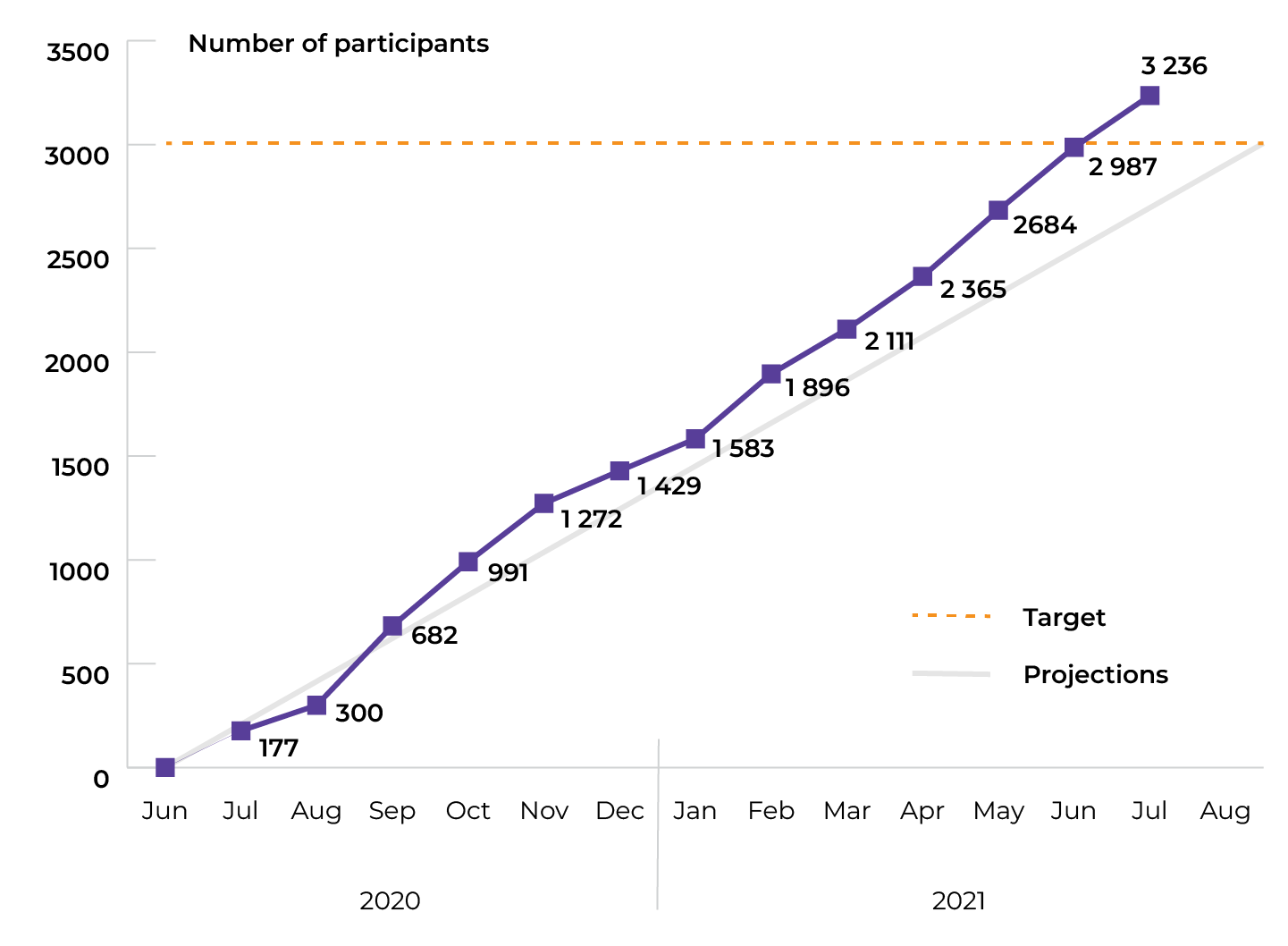
Title of table: Depiction of how participation has progressed in 2020
| July | August | September | October | November | December |
|---|---|---|---|---|---|
| 177 | 300 | 682 | 991 | 1272 | 1429 |
Title of table: Depiction of how participation has progressed in 2021
| January | February | March | April | Mai | June | July |
|---|---|---|---|---|---|---|
| 1583 | 1896 | 2111 | 2365 | 2684 | 2987 | 3236 |
Data source: Results of the lung screening demonstration program deployed by l’IUCPQ (ucipq.qc.ca) and financed by the Canadian Partnership Against Cancer
Topic: Implementing lung cancer screening
Title of image: Percentage of participants by age group
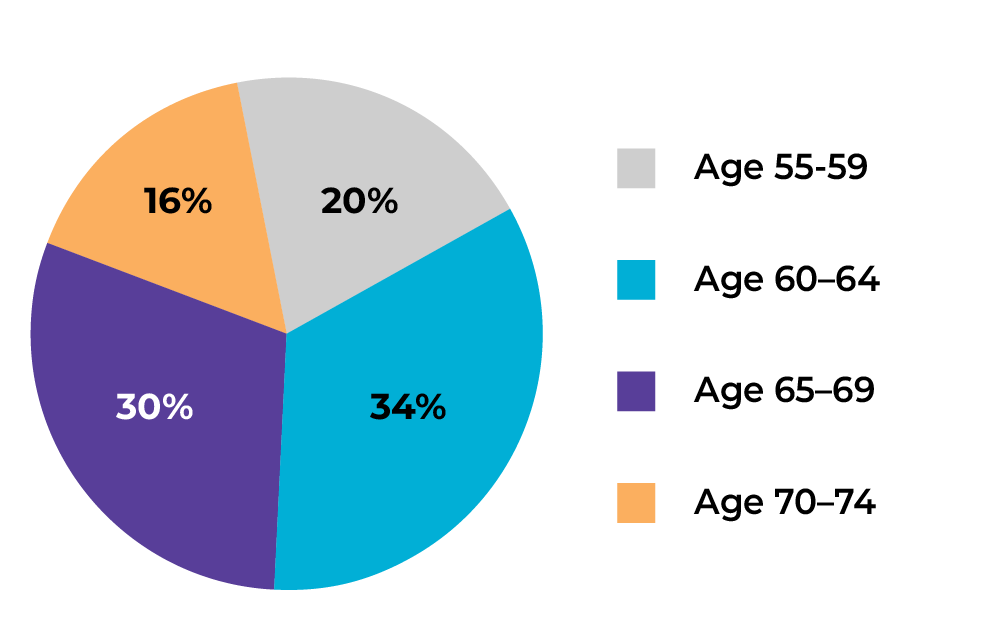
Data source: Results of the lung screening demonstration program deployed by l’IUCPQ (ucipq.qc.ca) and financed by the Canadian Partnership Against Cancer
Topic: Implementing lung cancer screening
Title of image: Percentage of patients referred by a family physician

Data source: Results of the lung screening demonstration program deployed by l’IUCPQ (ucipq.qc.ca) and financed by the Canadian Partnership Against Cancer
Topic: Implementing lung cancer screening
Title of image: Percentage of referrals to the I QUIT NOW telephone line
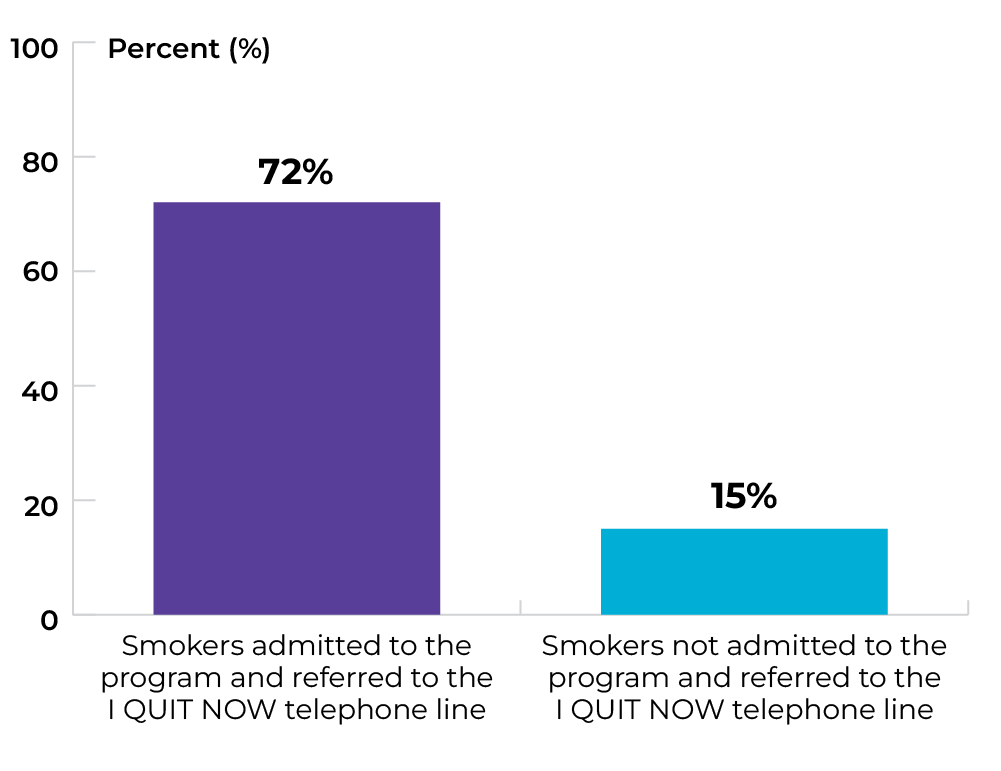
Data source: Results of the lung screening demonstration program deployed by l’IUCPQ (ucipq.qc.ca) and financed by the Canadian Partnership Against Cancer
Priority 4 Action 2: Ensure rural and remote communities have the resources required to better serve their people
Topic: Increasing access to virtual care
Title of image: Using telehealth
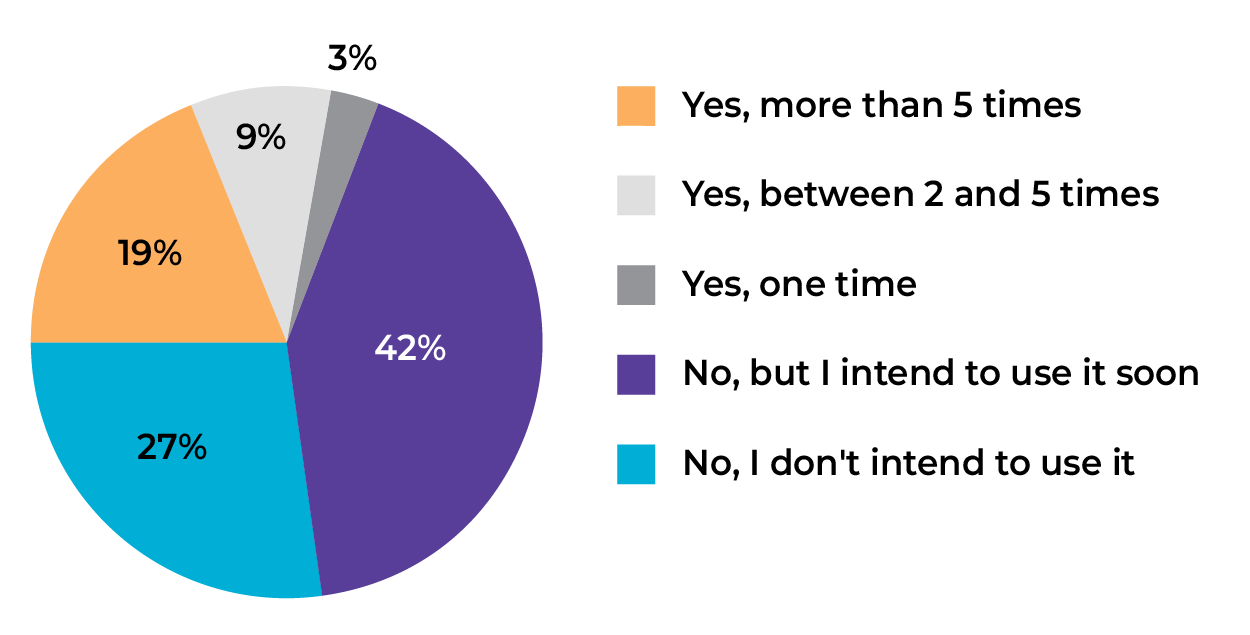
Title of table: Using telehealth
| Using telehealth | Percent |
|---|---|
| Yes, more than 5 times | 19% |
| Yes, between 2 and 5 times | 9% |
| Yes, one time | 3% |
| No, but I intend to use it soon | 42% |
| No, I don’t intend to use it | 27% |
Data source: Data from the report produced by CIUSSS de l’Estrie-CHUS (santeestrie.qc.ca) as part of the Virtual Care Services project funded by the Canadian Partnership Against Cancer
Topic: Increasing access to virtual care
Title of image: Support for using telehealth
Note: These results demonstrate that respondents understand and agree to these changes, but that there are still challenges when it comes to practical application and the integration of telehealth into the OPN practice.

| Comment | Strongly agree | Agree | Disagree | Strongly disagree | Not applicable |
|---|---|---|---|---|---|
| I understand the purpose and strategic objective of the project. | 39 | 57 | 4 | 0 | 0 |
| I see the benefits that this project will bring to users. | 32 | 57 | 12 | 0 | 0 |
| I see the benefits that this project will bring to my work. | 22 | 54 | 23 | 1 | 0 |
| I feel that my colleagues are open to change. | 7 | 67 | 19 | 3 | 4 |
| I am confident in my ability to adopt new ways of working. | 29 | 61 | 9 | 1 | 0 |
| I use virtual meetings with my patients when I see the added value. | 16 | 32 | 13 | 1 | 38 |
| I feel supported and am able to share my questions. | 23 | 42 | 19 | 4 | 12 |
| I feel that the necessary means and conditions for success are available in order to implement telehealth into the practice of oncology pivot nurses. | 17 | 25 | 38 | 16 | 4 |
| I am taking initiatives to incorporate telehealth into my OPN work. | 12 | 29 | 41 | 6 | 13 |
Data source: Data from the report produced by CIUSSS de l’Estrie-CHUS (santeestrie.qc.ca) as part of the Virtual Care Services project funded by the Canadian Partnership Against Cancer
Topic: Increasing access to virtual care
Title of image: Satisfaction of professionals
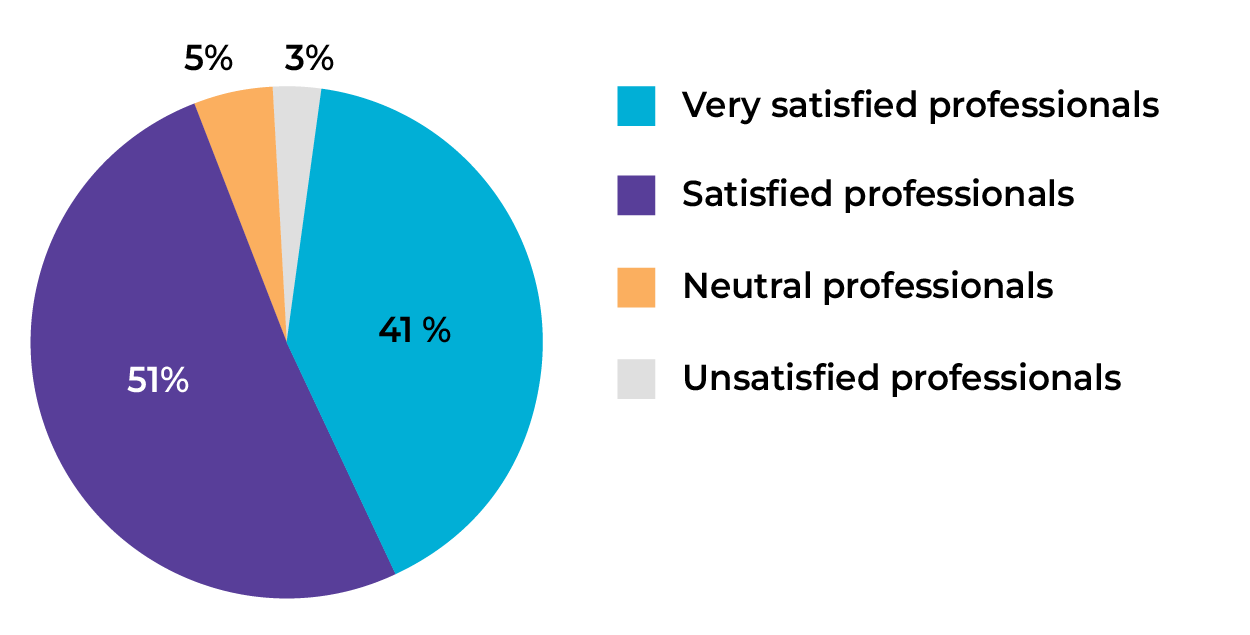
Data source: Data from the report produced by CIUSSS de l’Estrie-CHUS (santeestrie.qc.ca) as part of the Virtual Care Services project funded by the Canadian Partnership Against Cancer
Topic: Increasing access to virtual care
Title of image: Main challenges of telehealth
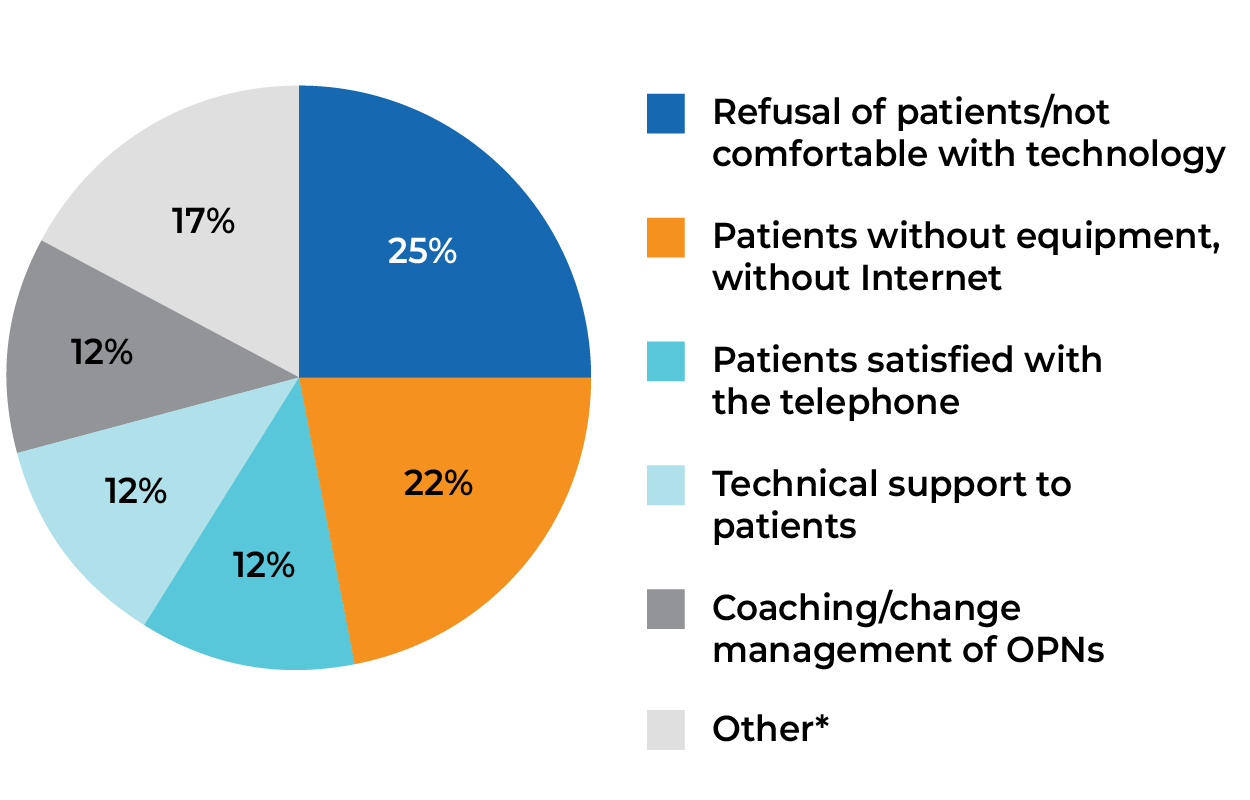
*Other reasons: too complex; the professionals do not offer telehealth services; the facility’s Internet connection; the patient’s Internet connection; the patient’s training; delicate/confidential subjects; additional stress for patients
Data source: Data from the report produced by CIUSSS de l’Estrie-CHUS (santeestrie.qc.ca) as part of the Virtual Care Services project funded by the Canadian Partnership Against Cancer
Priority 5 Action 1: Integrate the full spectrum of information and support services to ensure people are fully supported throughout the cancer experience
Topic: Improving availability of information and support
Title of image: Patient challenges after treatmen
Data source: Data from a report produced by the CISSS de Laval (lavalensante.com) as part of the project on transition – Life After Cancer – financed by the Canadian Partnership Against Cancer
Topic: Improving availability of information and support
Title of image: Needs identified by patients
Note: According to patients, having access to information on paper or on a website and being able to converse with a healthcare professional allows them to feel better equipped to face the period after the end of their treatment.
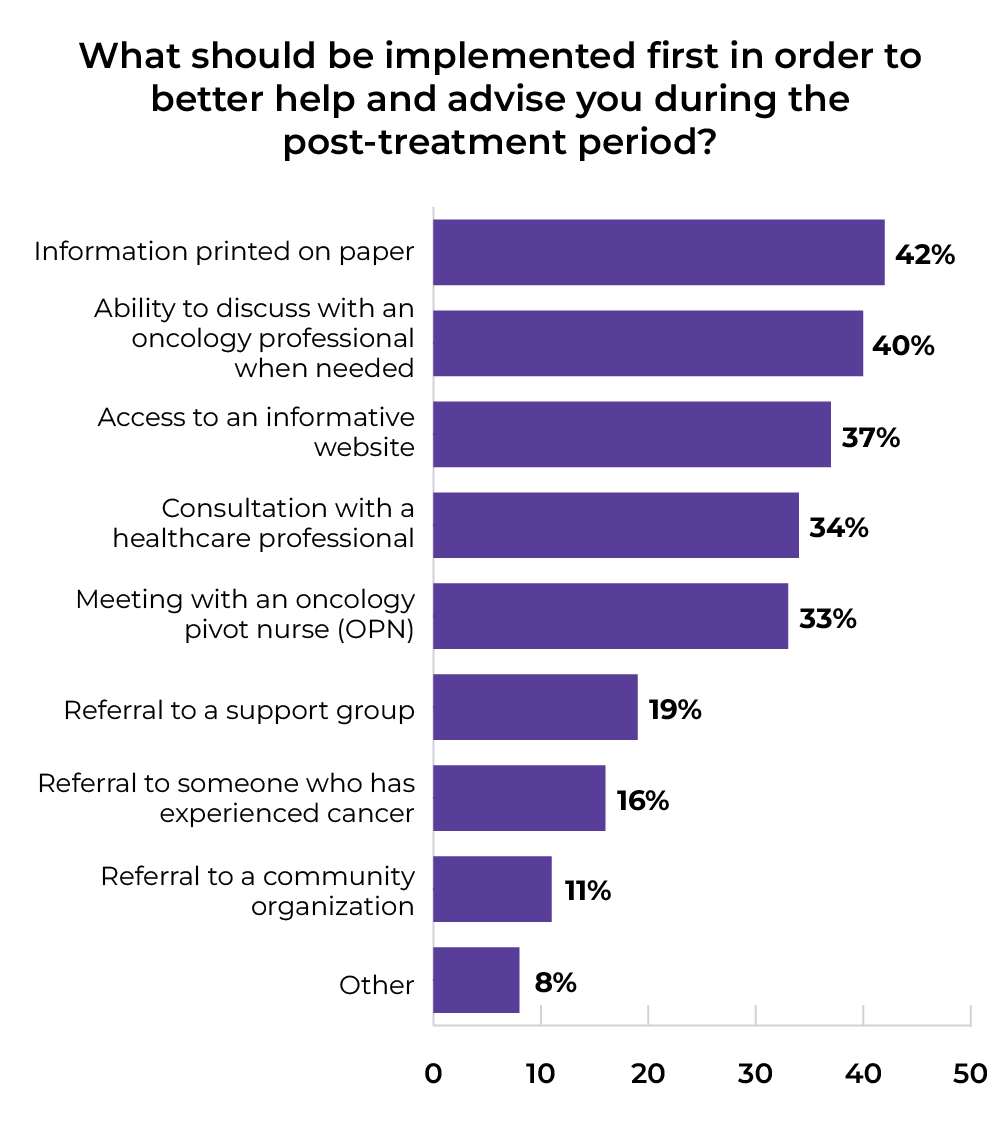
Title of table: Needs identified by patients
| What should be implemented first in order to better help and advise you during the post-treatment period? | Percent |
|---|---|
| Information printed on paper | 42% |
| Ability to discuss with an oncology professional when needed | 40% |
| Access to an informative website | 37% |
| Consultation with a healthcare professional | 34% |
| Meeting with an oncology pivot nurse (OPN) | 33% |
| Referral to a support group | 19% |
| Referral to someone who has experienced cancer | 16% |
| Referral to a community organization | 11% |
| Other | 8% |
Data source: Data from a report produced by the CISSS de Laval (lavalensante.com) as part of the project on transition – Life After Cancer – financed by the Canadian Partnership Against Cancer
Topic: Improving availability of information and support
Title of image: Needs of front line professionals
Note: Healthcare professionals working on the front lines have a great need for tools and knowledge to better support their patients after the end of cancer treatment.
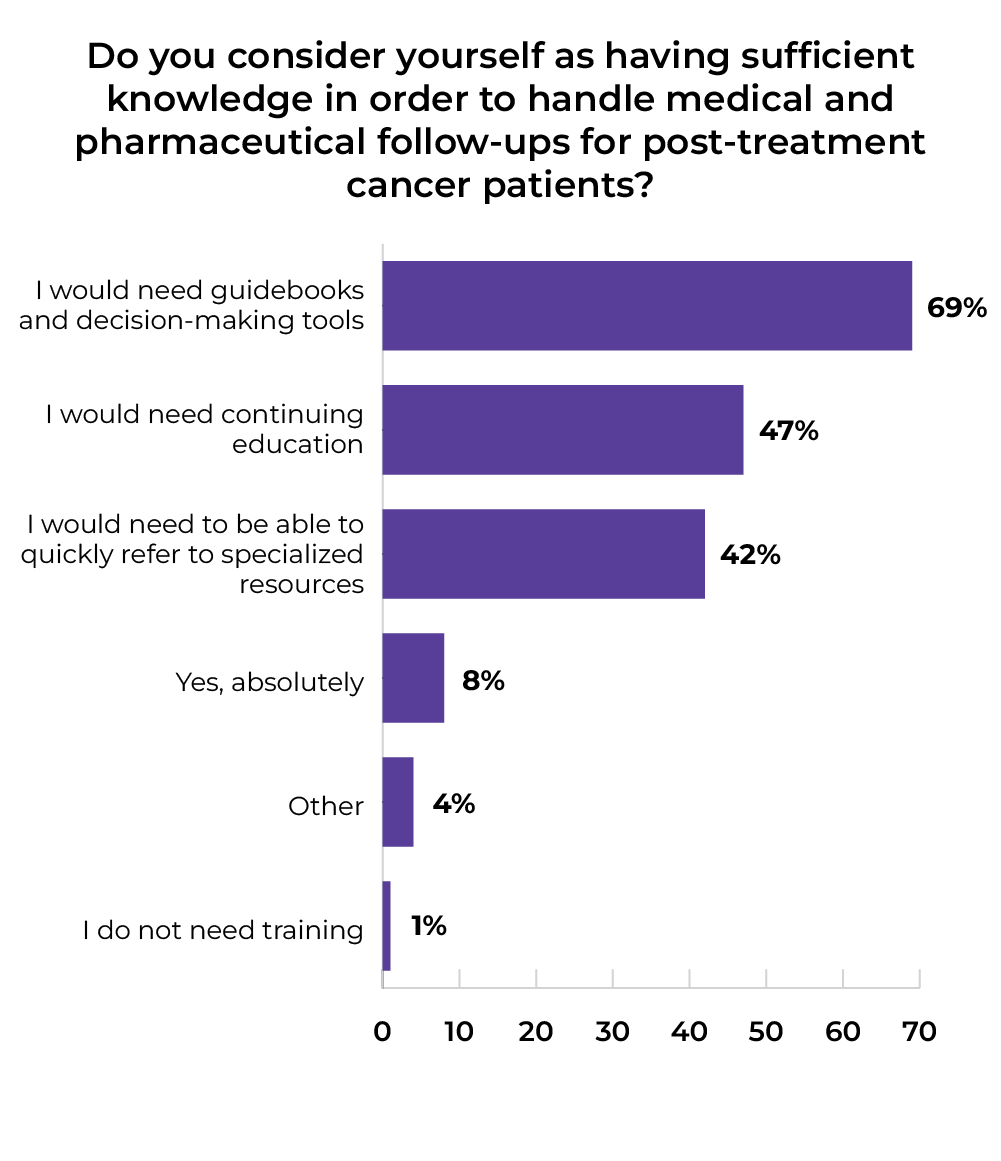
Title of table: Needs of front line professionals
| Do you consider yourself as having sufficient knowledge in order to handle medical and pharmaceutical follow-ups for post-treatment cancer patients? | Percent |
|---|---|
| I would need guidebooks and decision-making tools | 69% |
| I would need continuing education | 47% |
| I would need to be able to quickly refer to specialized resources | 42% |
| Yes, absolutely | 8% |
| Other | 4% |
| I do not need training | 1% |
Data source: Data from a report produced by the CISSS de Laval (lavalensante.com) as part of the project on transition – Life After Cancer – financed by the Canadian Partnership Against Cancer
Topic: Improving availability of information and support
Title of image: Level of knowledge of the transitional period
Note: The majority of oncology professionals admit to not having sufficient knowledge on the transition period and that they require more training on the subject.
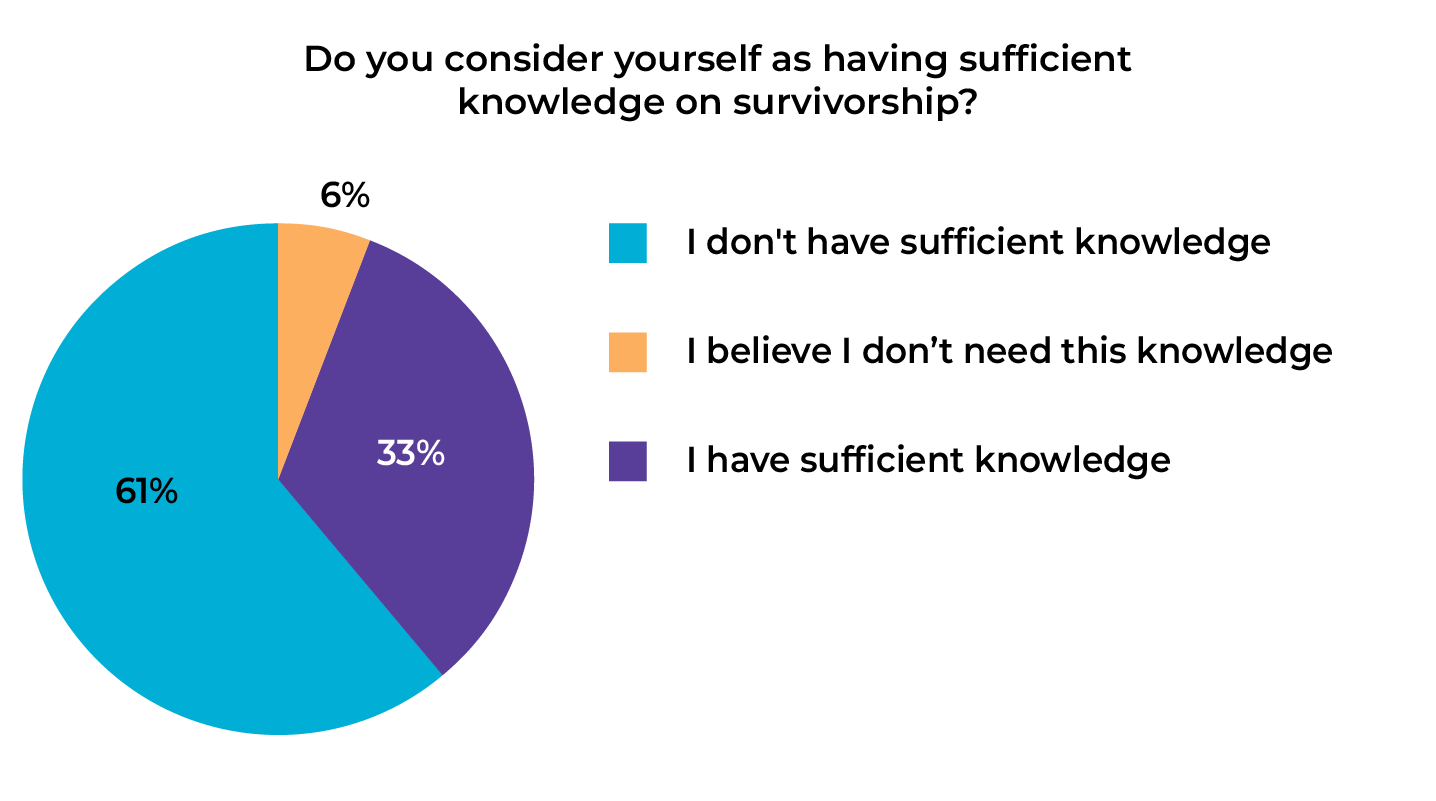
Data source: Data from a report produced by the CISSS de Laval (lavalensante.com) as part of the project on transition – Life After Cancer – financed by the Canadian Partnership Against Cancer
Topic: Improving availability of information and support
Title of image: Interest in receiving training on transition
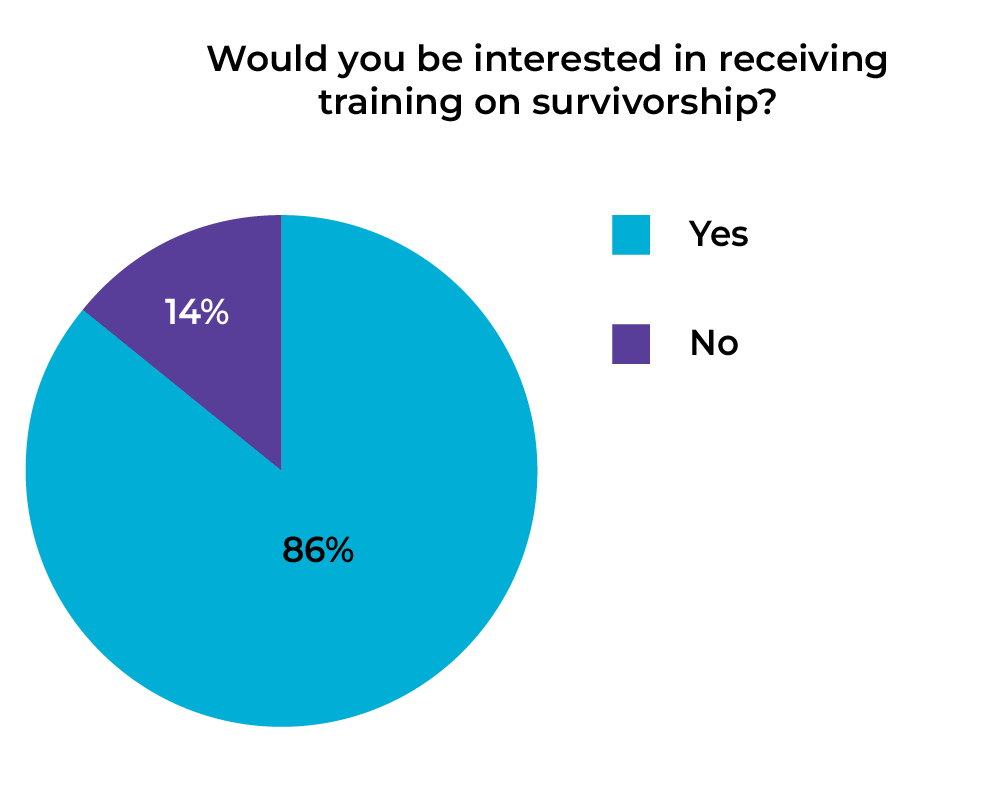 Data source: Data from a report produced by the CISSS de Laval (lavalensante.com) as part of the project on transition – Life After Cancer – financed by the Canadian Partnership Against Cancer
Data source: Data from a report produced by the CISSS de Laval (lavalensante.com) as part of the project on transition – Life After Cancer – financed by the Canadian Partnership Against Cancer
